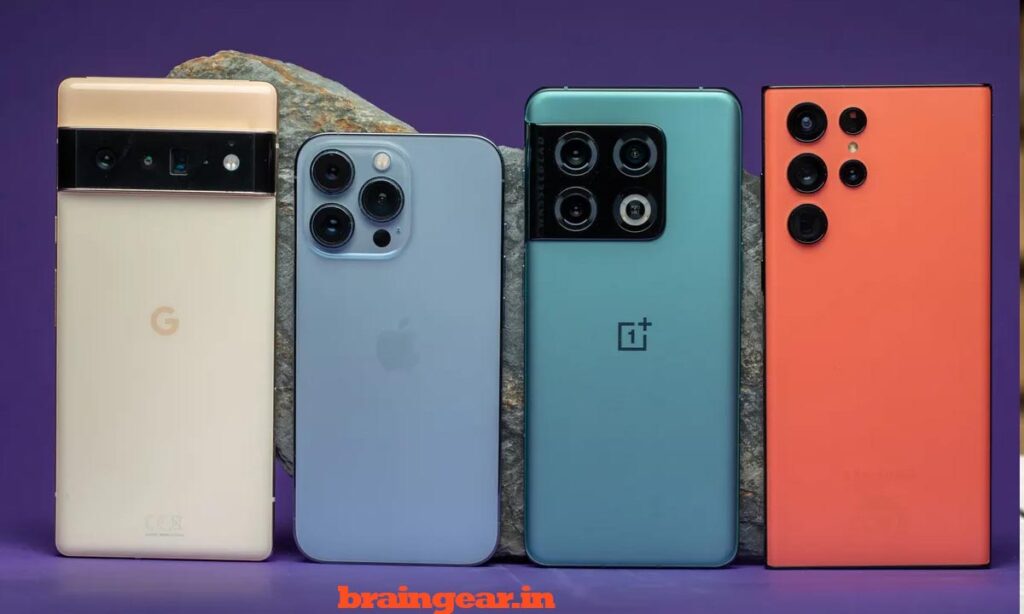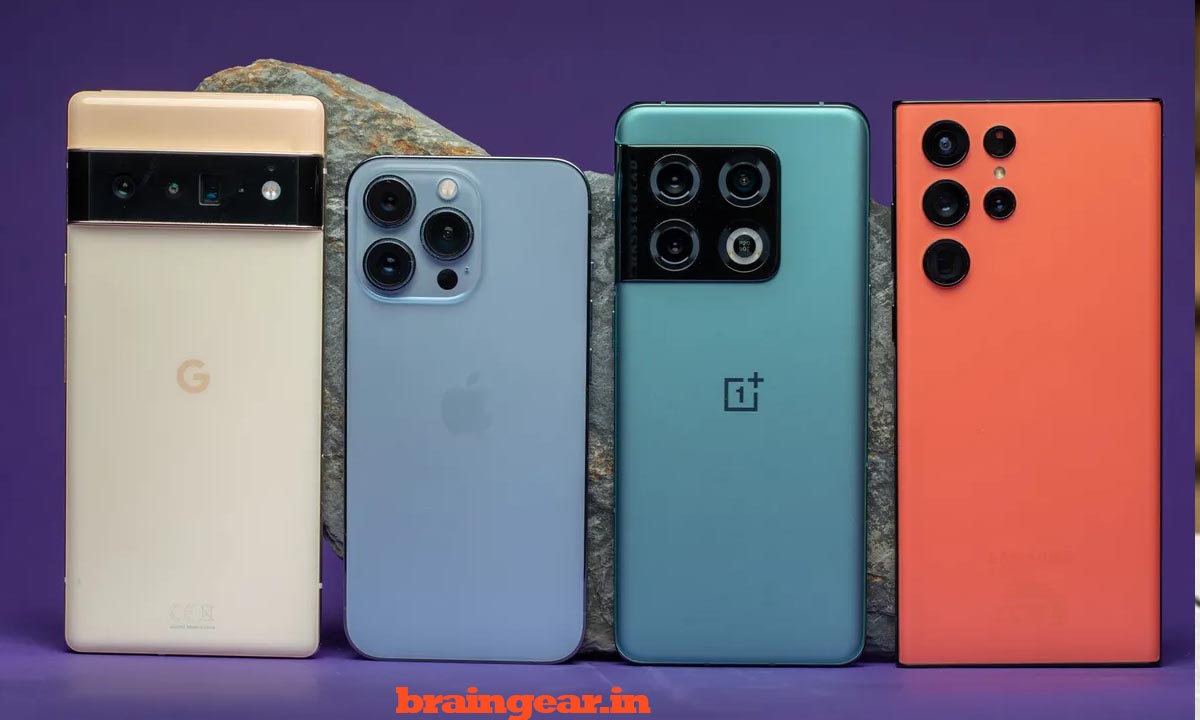In 2025, the smartphone market is buzzing with cutting-edge technology, and 5G connectivity has become a must-have feature for anyone looking to stay ahead in the digital world. With blazing-fast speeds, seamless streaming, and lag-free gaming, 5G smartphones are transforming how we connect, work, and play. But with so many options flooding the market, from budget-friendly models to premium flagships, how do you pick the best 5G smartphone in 2025? At braingear, we’re here to guide you through the process with expert insights and practical tips. This comprehensive guide will help you navigate the key factors to consider, ensuring you find a device that perfectly matches your needs, budget, and lifestyle.
Why Choosing the Right 5G Smartphone Matters
The arrival of 5G has revolutionized mobile connectivity, offering download speeds up to 100 times faster than 4G, lower latency, and better network reliability. Whether you’re streaming 4K videos, gaming online, or working remotely, a 5G smartphone ensures you’re future-proofed for the next wave of digital innovation. However, not all 5G phones are created equal. Factors like network compatibility, processor performance, battery life, and camera quality can make or break your experience. This article breaks down everything you need to know to make an informed decision, backed by real-world examples and expert advice from the team at braingear.
Key Factors to Consider When Choosing a 5G Smartphone
1. Understand Your 5G Needs
Before diving into specs, ask yourself: How will I use 5G? Your usage patterns will shape your choice. Are you a power user who streams high-definition content or plays graphics-intensive games? Do you need a phone for multitasking with 5G-heavy apps? Or are you simply looking for a reliable device for everyday tasks like browsing and video calls?
For example, a professional working remotely might prioritize a phone with mmWave 5G support for ultra-fast speeds in urban areas, while a suburban user might focus on sub-6GHz for broader coverage. According to a 2024 guide from 5G World Pro, evaluating your specific needs helps narrow down the overwhelming array of options.
2. 5G Network Compatibility
5G networks come in two main types: mmWave and sub-6GHz. mmWave delivers lightning-fast speeds (up to 10 Gbps) but is limited to dense urban areas. Sub-6GHz offers slower speeds but wider coverage, making it ideal for rural or suburban regions.
Key Phones with Both mmWave and Sub-6GHz Support:
- Apple iPhone 16 Pro Max: Offers balanced 5G performance across all locations.
- Samsung Galaxy S25 Ultra: Excels in urban areas with mmWave and maintains reliability in rural settings.
Check your carrier’s 5G coverage map (e.g., AT&T, T-Mobile, or Verizon in the US) to ensure your phone supports the bands available in your area. A phone without proper band support could leave you stuck on 4G, negating the benefits of 5G.

3. Processor Performance
A powerful processor is the backbone of a great 5G experience. 5G-intensive tasks like streaming, gaming, and multitasking demand chipsets that can handle high data throughput without lag. Top processors in 2025 include:
- Qualcomm Snapdragon 8 Elite: Found in devices like the Samsung Galaxy S25 Ultra, optimized for 5G performance and multitasking.
- Apple A18 Bionic: Powers the iPhone 16 series, offering efficient 5G management and AI-driven features.
- Google Tensor G4: Featured in the Pixel 9a, balancing performance and power efficiency.
For example, a gamer might choose the OnePlus 13 Pro with a Snapdragon 8 Gen 3 for its ability to handle demanding apps, while a casual user might opt for the Google Pixel 9a for its smooth everyday performance.
4. Battery Life and Power Management
5G connectivity can be power-hungry, so a robust battery and smart power management are crucial. Look for phones with at least a 4,500mAh battery and features like adaptive 5G switching to conserve energy.
Top Picks for Battery Life:
- Samsung Galaxy S25 Ultra: 5,000mAh battery with intelligent power-saving modes.
- Google Pixel 9a: 5,100mAh battery, lasting up to 34 hours in tests.
- iPhone 16 Pro Max: 4,422mAh with smart data mode to switch between 4G and 5G.
A real-world example: A travel blogger using the iPhone 16 Pro Max reported seamless 5G streaming during a cross-country trip without needing a recharge, thanks to its optimized power efficiency.
5. Display Quality
A high-quality display enhances your 5G experience, especially for streaming or gaming. Look for phones with AMOLED or OLED panels, high refresh rates (90Hz or 120Hz), and bright screens for outdoor visibility.
Display Highlights:
- Samsung Galaxy S25 Ultra: 6.9-inch Dynamic AMOLED 2X with 120Hz and anti-reflective coating.
- iPhone 16 Pro Max: 6.7-inch Super Retina XDR OLED with 120Hz ProMotion.
- Xiaomi 14 Ultra: 6.8-inch AMOLED with 120Hz and vibrant colors.
For instance, a movie enthusiast might prefer the Galaxy S25 Ultra’s large, vibrant display for an immersive Netflix experience, while a professional might choose the iPhone 16 Pro Max for its crisp visuals during video calls.
6. Camera Capabilities
If photography or videography is a priority, prioritize phones with advanced camera systems. 5G enables faster uploads and real-time editing, making camera quality a key consideration.
Top Camera Phones:
- Xiaomi 15 Ultra: Features a 1-inch sensor for exceptional low-light performance.
- Google Pixel 9 Pro: 50MP main sensor with AI-powered image processing.
- iPhone 16 Pro Max: Triple-lens system with 48MP main camera and advanced video features.
Case Study: A freelance photographer tested the Pixel 9 Pro’s AI-driven “Add Me” feature, which seamlessly composites group shots without a tripod, saving time during outdoor shoots.
7. Software and Updates
Long-term software support ensures your phone stays secure and compatible with future 5G advancements. Look for brands offering extended update cycles:
- Samsung: Up to seven years of updates for the Galaxy S25 series and A16 5G.
- Google: Seven years of support for the Pixel 9 series, until 2032.
- Apple: Typically five years of iOS updates for the iPhone 16 series.
For example, the Samsung Galaxy A16 5G, a budget-friendly option, offers six years of updates, making it ideal for cost-conscious users who want longevity.
8. Budget and Value
5G smartphones in 2025 range from $200 to over $1,500, catering to various budgets. Here’s a quick comparison:
| Phone | Price | Key Features |
|---|---|---|
| Samsung Galaxy A16 5G | $200 | 6.5-inch AMOLED, 6-year updates, Exynos 1330 |
| Google Pixel 9a | $500 | Tensor G4, 120Hz OLED, 7-year updates |
| iPhone 16 Pro Max | $1,199 | A18 Bionic, 120Hz OLED, mmWave 5G |
| Samsung Galaxy S25 Ultra | $1,299 | Snapdragon 8 Elite, 200MP camera, 7-year updates |
Budget-conscious buyers might opt for the Galaxy A16 5G, while those seeking premium features might choose the S25 Ultra for its unmatched performance.
What’s New in 5G Smartphones for 2025
The 5G smartphone landscape in 2025 is marked by exciting advancements:
- AI Integration: Devices like the Galaxy S25 Ultra and Pixel 9 series feature AI-driven tools for photo editing, productivity, and personalization.
- Foldable Designs: The Samsung Galaxy Z Fold 6 and Motorola Razr 60 Ultra offer innovative form factors for multitasking and portability.
- Enhanced Displays: Higher brightness (up to 2,700 nits on the Pixel 9) and anti-reflective coatings improve outdoor visibility.
- Battery Improvements: Larger batteries (e.g., 5,100mAh in the Pixel 9a) and faster charging (up to 100W on the OnePlus 13) are standard.
These innovations make 2025 an exciting year to upgrade, but they also underscore the importance of choosing a phone that aligns with your priorities.
Pros and Cons of Top 5G Smartphones
| Phone | Pros | Cons |
|---|---|---|
| Samsung Galaxy S25 Ultra | Excellent 5G performance, 200MP camera, 7-year updates | High price, large size may not suit all users |
| iPhone 16 Pro Max | Seamless iOS experience, great battery life, mmWave support | Expensive, no microSD slot |
| Google Pixel 9a | Affordable, 7-year updates, excellent camera | Smaller screen, bezels may feel dated |
| Xiaomi 14 Ultra | Budget-friendly flagship, 1-inch camera sensor, fast charging | Limited US carrier support, shorter software updates |
How to Ensure You’re Getting the Best Deal
- Check Carrier Deals: Many carriers offer discounts or trade-in programs for 5G phones.
- Compare Retailers: Sites like Amazon or Flipkart often have sales, especially during events like Prime Day 2025.
- Look for Bundles: Some brands bundle accessories (e.g., earbuds or chargers) with premium models.
- Read Reviews: Check trusted sources like braingear for in-depth reviews and comparisons.
For more tech insights, visit our About Us page to learn about our mission to deliver reliable advice, or reach out via our Contact Us page for personalized recommendations.
FAQs About Choosing the Best 5G Smartphone in 2025
What is the difference between mmWave and sub-6GHz 5G?
mmWave offers ultra-fast speeds (up to 10 Gbps) but is limited to urban areas with short-range coverage. Sub-6GHz provides broader coverage with slower speeds, ideal for suburban or rural areas. Choose based on your location and carrier’s network.
Which 5G smartphone has the best battery life in 2025?
The Google Pixel 9a stands out with a 5,100mAh battery, lasting up to 34 hours in tests. The Samsung Galaxy S25 Ultra (5,000mAh) and iPhone 16 Pro Max (4,422mAh) also offer excellent endurance with power-saving features.
Are budget 5G phones worth it?
Yes, budget options like the Samsung Galaxy A16 5G ($200) offer solid 5G performance, decent cameras, and long-term software support. They’re ideal for basic tasks like browsing, streaming, and calls.
Which 5G phone has the best camera in 2025?
The Xiaomi 15 Ultra leads with its 1-inch sensor for superior low-light photos. The Google Pixel 9 Pro and iPhone 16 Pro Max are also top contenders, with advanced AI processing and versatile lens systems.
How important is software support for a 5G phone?
Long-term software updates ensure security and compatibility with future 5G advancements. Samsung and Google offer up to seven years, while Apple typically provides five, making them reliable choices.
Can I use a 5G phone on a 4G network?
Yes, most 5G phones are backward compatible with 4G networks. This ensures you can use your phone in areas without 5G coverage, though you won’t benefit from faster speeds.
Conclusion
Choosing the best 5G smartphone in 2025 doesn’t have to be overwhelming. By focusing on your needs—whether it’s network compatibility, battery life, camera quality, or budget—you can find a device that enhances your digital life. From the powerful Samsung Galaxy S25 Ultra to the budget-friendly Galaxy A16 5G, there’s a 5G phone for everyone. At braingear, we’re committed to helping you make informed tech decisions. Share your thoughts in the comments, subscribe to our newsletter for more tech tips, or contact us at Contact Us for personalized advice. Stay connected, and happy shopping!
External Resources:
- PCMag’s Best 5G Phones for 2025
- 5G World Pro’s Guide to Choosing a 5G Smartphone
- ZDNET’s Expert-Tested 5G Phones
Note: All photos and videos have been taken from Google or YouTube, so if you have any problem with the photo then mail us.
If you find any problem in this post or want to remove this post, then contact us: CONTACT US

